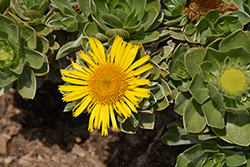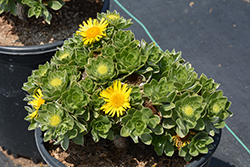It's all about ...
plants

Height: 30 inches
Spread: 30 inches
Sunlight:
![]()
Hardiness Zone: (annual)
Other Names: Nauplius sericeus, Odontospermum sericeus
Description:
A mounding plant presenting large, bright yellow daisy-like flowers above silvery green foliage; flowers from late winter to early summer with sporadic bloom year-round; water infrequently; perfect for coastal gardens, rockeries or containers
Ornamental Features
Canary Island Daisy features showy yellow daisy flowers with gold eyes at the ends of the stems from late winter to early summer. The flowers are excellent for cutting. Its tomentose oval leaves remain green in colour with hints of silver throughout the year.
Landscape Attributes
Canary Island Daisy is a dense herbaceous annual with an upright spreading habit of growth. Its medium texture blends into the garden, but can always be balanced by a couple of finer or coarser plants for an effective composition.
This is a relatively low maintenance plant, and is best cleaned up in early spring before it resumes active growth for the season. It is a good choice for attracting butterflies to your yard, but is not particularly attractive to deer who tend to leave it alone in favor of tastier treats. It has no significant negative characteristics.
Canary Island Daisy is recommended for the following landscape applications;
- Mass Planting
- Rock/Alpine Gardens
- Border Edging
- General Garden Use
- Groundcover
- Container Planting
Planting & Growing
Canary Island Daisy will grow to be about 30 inches tall at maturity, with a spread of 30 inches. Its foliage tends to remain dense right to the ground, not requiring facer plants in front. Although it's not a true annual, this plant can be expected to behave as an annual in our climate if left outdoors over the winter, usually needing replacement the following year. As such, gardeners should take into consideration that it will perform differently than it would in its native habitat.
This plant should only be grown in full sunlight. It prefers dry to average moisture levels with very well-drained soil, and will often die in standing water. It is considered to be drought-tolerant, and thus makes an ideal choice for a low-water garden or xeriscape application. This plant does not require much in the way of fertilizing once established. It is not particular as to soil pH, but grows best in sandy soils, and is able to handle environmental salt. It is somewhat tolerant of urban pollution. This species is not originally from North America. It can be propagated by division.
Canary Island Daisy is a fine choice for the garden, but it is also a good selection for planting in outdoor pots and containers. With its upright habit of growth, it is best suited for use as a 'thriller' in the 'spiller-thriller-filler' container combination; plant it near the center of the pot, surrounded by smaller plants and those that spill over the edges. It is even sizeable enough that it can be grown alone in a suitable container. Note that when growing plants in outdoor containers and baskets, they may require more frequent waterings than they would in the yard or garden.

